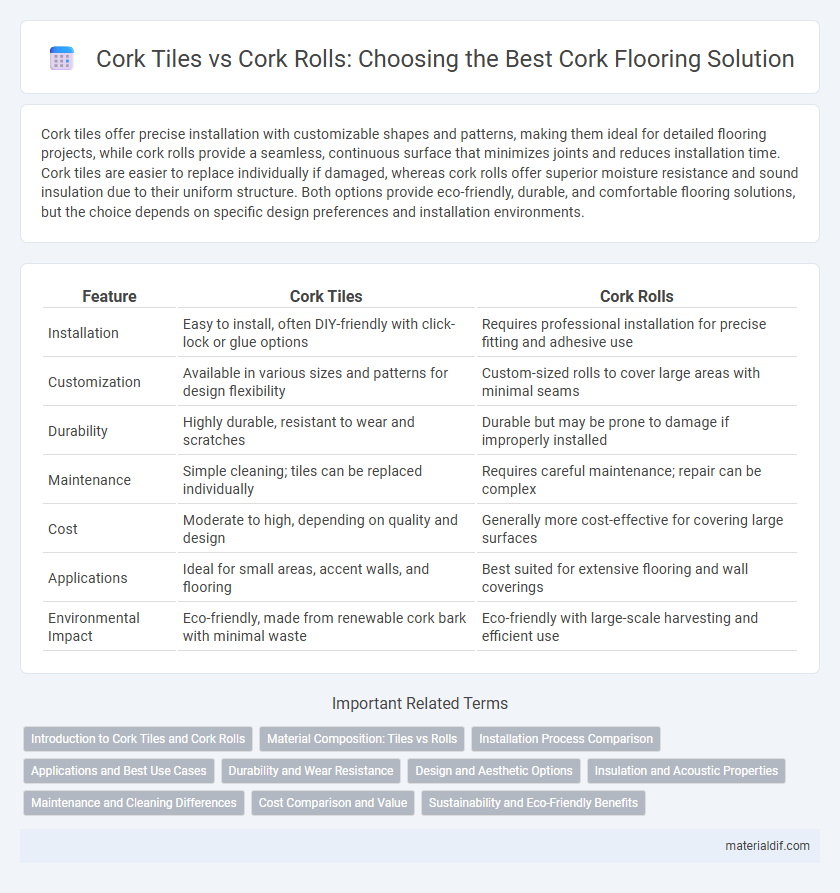Cork tiles offer precise installation with customizable shapes and patterns, making them ideal for detailed flooring projects, while cork rolls provide a seamless, continuous surface that minimizes joints and reduces installation time. Cork tiles are easier to replace individually if damaged, whereas cork rolls offer superior moisture resistance and sound insulation due to their uniform structure. Both options provide eco-friendly, durable, and comfortable flooring solutions, but the choice depends on specific design preferences and installation environments.
Table of Comparison
| Feature | Cork Tiles | Cork Rolls |
|---|---|---|
| Installation | Easy to install, often DIY-friendly with click-lock or glue options | Requires professional installation for precise fitting and adhesive use |
| Customization | Available in various sizes and patterns for design flexibility | Custom-sized rolls to cover large areas with minimal seams |
| Durability | Highly durable, resistant to wear and scratches | Durable but may be prone to damage if improperly installed |
| Maintenance | Simple cleaning; tiles can be replaced individually | Requires careful maintenance; repair can be complex |
| Cost | Moderate to high, depending on quality and design | Generally more cost-effective for covering large surfaces |
| Applications | Ideal for small areas, accent walls, and flooring | Best suited for extensive flooring and wall coverings |
| Environmental Impact | Eco-friendly, made from renewable cork bark with minimal waste | Eco-friendly with large-scale harvesting and efficient use |
Introduction to Cork Tiles and Cork Rolls
Cork tiles and cork rolls represent two versatile forms of natural cork flooring, each offering unique installation and design benefits. Cork tiles are pre-cut squares that facilitate easy customization and pattern creation, making them ideal for detailed flooring projects. Cork rolls provide continuous sheets best suited for seamless coverage and large areas, enhancing uniformity and reducing installation time.
Material Composition: Tiles vs Rolls
Cork tiles and cork rolls both consist primarily of natural cork granules derived from the bark of the cork oak tree, but their material composition differs in density and structure. Cork tiles are typically denser and compressed into rigid, modular units that enhance durability and provide consistent surface properties, making them ideal for high-traffic areas. Cork rolls, on the other hand, feature a more flexible, less compressed composition allowing for easy installation over irregular surfaces with minimal seams, often preferred for larger, continuous flooring applications.
Installation Process Comparison
Cork tiles offer a straightforward installation process with individual pieces that can be easily aligned and adjusted for precise fitting, ideal for DIY projects. Cork rolls provide a continuous surface that minimizes seams and reduces installation time but often require professional handling due to their size and weight. Both materials typically use adhesive methods, but cork rolls demand careful measurement and cutting to fit the space without gaps or overlaps.
Applications and Best Use Cases
Cork tiles offer precise dimensions ideal for customized flooring designs, making them suitable for residential spaces, offices, and small-scale commercial areas requiring easy repairs and replacements. Cork rolls provide continuous sheets perfect for large areas, such as gym floors or expansive retail spaces, ensuring a seamless, durable surface with enhanced acoustic and thermal insulation. Both options excel in moisture resistance and comfort, but tiles are favored for aesthetic flexibility while rolls are preferred for uniform coverage and ease of installation over broad surfaces.
Durability and Wear Resistance
Cork tiles offer superior durability and wear resistance due to their thicker profile and denser composition compared to cork rolls. While cork rolls provide flexible coverage ideal for large areas, they are generally more susceptible to dents and surface damage under heavy foot traffic. The interlocking design of cork tiles helps maintain structural integrity, making them a more resilient choice for high-use spaces.
Design and Aesthetic Options
Cork tiles offer versatile design possibilities with individual patterns and colors that can create intricate floor layouts or geometric designs, enhancing aesthetic appeal in residential and commercial spaces. Cork rolls provide a seamless, uniform appearance, ideal for large areas where a continuous, minimalist style is desired, reducing visible seams and creating a sleek look. Both options support natural textures and warm tones unique to cork, contributing to an inviting and eco-friendly interior design.
Insulation and Acoustic Properties
Cork tiles provide superior thermal insulation due to their thickness and density, making them ideal for maintaining consistent indoor temperatures. Cork rolls offer enhanced acoustic properties by minimizing sound transmission and reducing echo in large spaces, thanks to their continuous surface coverage. Both materials leverage cork's natural cellular structure to deliver effective insulation and soundproofing, but tiles excel in thermal performance while rolls are preferred for acoustic applications.
Maintenance and Cleaning Differences
Cork tiles require individual cleaning and sealing, making maintenance more meticulous but allowing spot repairs without disturbing the entire floor. Cork rolls offer a seamless surface that simplifies cleaning and reduces dirt accumulation in joints. Both options need gentle cleaning with pH-neutral cleaners and periodic resealing to preserve water resistance and durability.
Cost Comparison and Value
Cork tiles generally offer a higher upfront cost compared to cork rolls but provide greater design flexibility and easier replacement options, enhancing long-term value. Cork rolls tend to be more cost-effective for large areas, minimizing seams and installation time, which reduces labor expenses. Evaluating durability, maintenance, and area size is crucial for determining the best choice between cork tiles and cork rolls in terms of overall cost efficiency and value.
Sustainability and Eco-Friendly Benefits
Cork tiles offer precise installation with minimal waste, enhancing sustainability by allowing damaged sections to be replaced without discarding entire areas. Cork rolls provide a seamless, continuous surface that reduces waste during manufacturing and installation, maximizing the use of natural cork bark sustainably harvested from cork oak trees. Both options contribute to eco-friendly flooring solutions by utilizing renewable materials, promoting carbon sequestration, and supporting biodegradable end-of-life disposal.
cork tiles vs cork rolls Infographic

 materialdif.com
materialdif.com